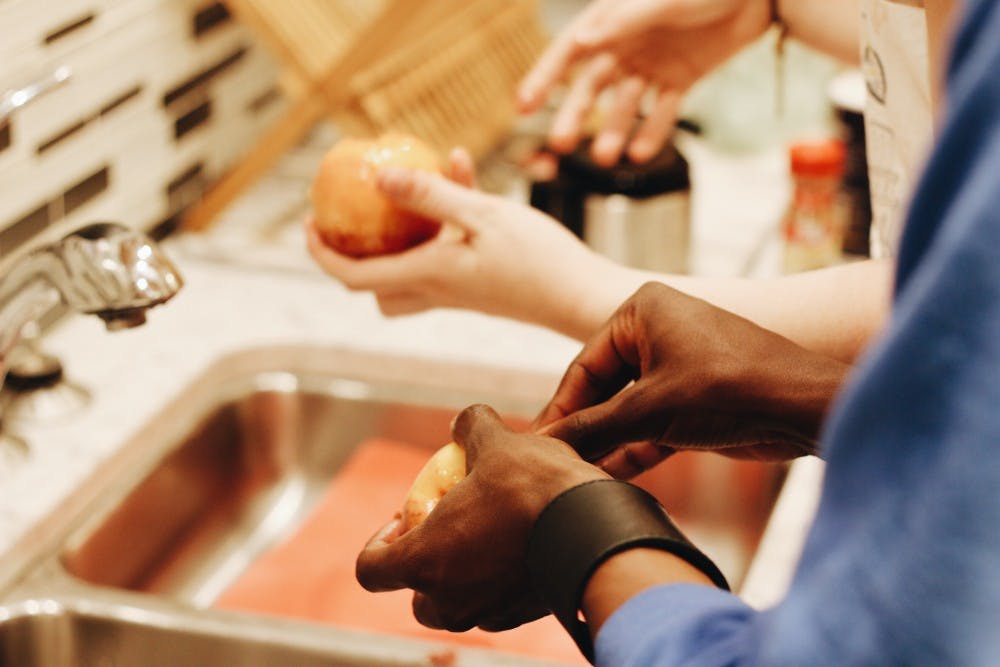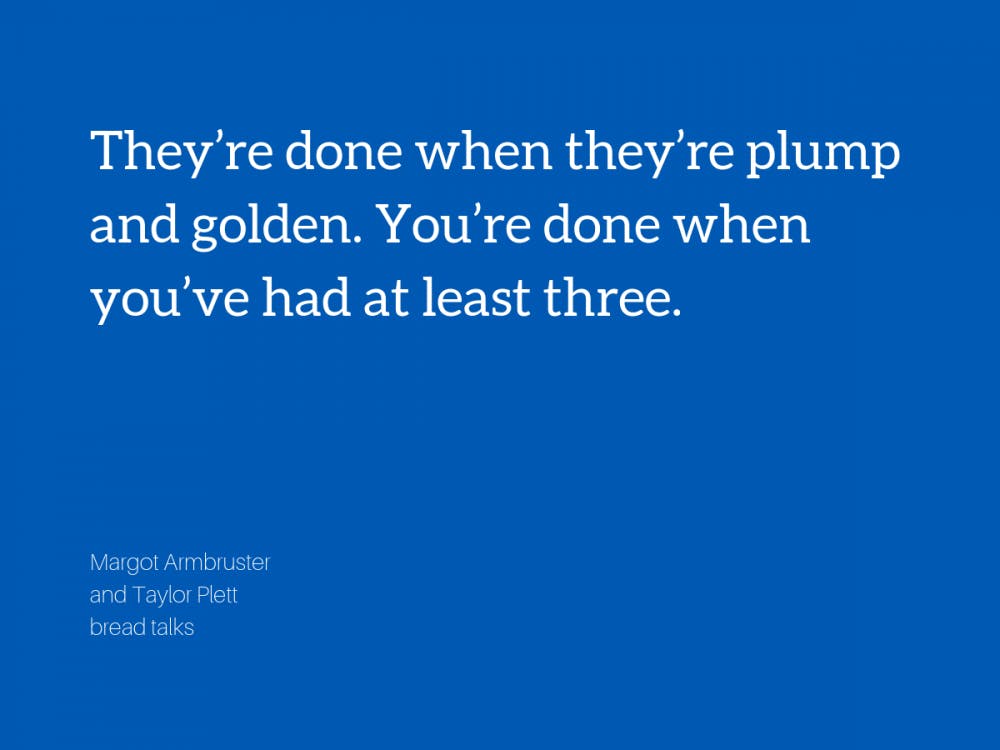Margot:
Picture this: it’s 10 p.m. on a Thursday night and I’m prying little bits of skin from a peach with my fingers. The weirdly lit, subterranean Wannamaker kitchen is filling up with steam, soft French jazz, and the sweet smell of ripe summer fruit.
James, Taylor and I are making peach hand pies. We’re invading the kitchen of a dorm we don’t live in for this purpose, shuffling together mismatched ingredients we bought mostly at the Lobby Shop. But I’ve been looking forward to this all week, and as the stubborn peel lifts at last from the blanched peach, I feel my shoulders unclenching.
Taylor:
For the past couple weeks, I’ve been preaching the good news of peach hand pies. These pockets of seasonal sunshine can be made en masse—and mostly on a dime. My pastry enthusiasm might seem misplaced (and I thank you, my friends, for feigning excitement about my latest baking endeavor), but these little pies mean a lot more than fresh-from-the-oven sugar. They’re a mile marker of my progress in a new philosophy. Or rather, a newly adopted one—time-tested and handed down generations of women on my mother's side of the family. The philosophy is simple: always have something to look forward to.
The idea is that mindfulness engenders gratitude, and that anticipation supersedes anxiety. But we don’t need big words to understand that when you know you’re going to Disneyland on Saturday, it’s easier to study for the test on Friday. This is textbook.
Looking forward may be easy enough at Duke—the “Disneyland” of academic and recreational opportunity. But for a practice we can sustain, say, throughout a lifetime, we must find ways to create these merry-making moments for ourselves. And it doesn’t take much, aside from planning in advance. This past Thursday, it took little more than sugar, butter, ripe peaches, and the wrong kind of flour...
Margot:
The pies, when they emerge from the oven, are sticky, haphazard, a little bit too puffy—the Lobby Shop only sells self-rising flour with baking powder, which definitely does NOT go in pie crust, built in. We’re proud of them anyway, because they’re ours, and because we’ve shared something tactile and intimate which will remain even once the filling’s mesmerizing syrup scent fades from the air.
Our project this semester is to make more memories like these. Taylor and I will be inviting professors, staff, and students—anyone with a great story to tell—to come talk, shove some dough around, and find peace with us. This week, our guest is my friend James, a magnetic, gap-toothed Kenyan boy with energy always running through his body. But gracefulness doesn’t imply technical skill: he begged us for a baking tutorial after scorching a batch of chocolate-chip cookies.
Taylor:
We embraced James’ task gladly. Because the caffeine-wired conversation which bore the Bread Talks brainchild into existence several months ago was all about this: sharing the joy and meaning we’d found in baking with others. Bread Talks is also very much an excuse to bake—you caught us. But above all, we hope this column delivers a little Mary Berry magic, a little Ratatouille wisdom into your week (folks, Anyone Can Bake). May you enjoy our mistakes, and may you make your own.
Margot:
Before you ask—no, we don’t have the culinary acumen to work for Bon Appetit. Yes, it angers us. Anyway, here’s the rundown of how this recipe from Food & Wine turned out for us three highly average bakers.
Step one: Boil the peaches until the skins start to slip off, then dunk them in ice water to stop them from cooking (this is called blanching). Finish peeling the skin off and cut them up into cute little chunks!

Photo courtesy of Taylor Plett.
Margot:
Get The Chronicle straight to your inbox
Sign up for our weekly newsletter. Cancel at any time.
James was trying to do thin slices here and I had to intervene. Round peach slices will not fit in your pies!
Step two: Cook those bad boys up with some cinnamon, brown and granulated sugar, vanilla, and lemon. (I was too cheap to buy vanilla or lemon but it still tasted great!)
Taylor:
You better hope your clothing will go home smelling like step two.
Step three: Make the dough by crumbling pieces of chilled butter into the flour, then adding ice water until the texture approximates play-doh. And yes, you can use your hands.

Taylor:
Do not eat the dough. It is not yummy. I know you will anyway but I’m telling you—do not.
Step four: Chill the dough and the filling.
Margot:
You’re supposed to do this in the fridge, but we used the freezer. I simply don’t understand why you would cause yourself suffering by waiting for these hand pies a minute longer than you have to—live fast, bake soon: freezer girls do it best.
Step five: Roll out the dough until it’s an eighth-inch thick. Cut out four-inch circles, then brush the edges with beaten egg and spoon in some filling. Press shut and brush all over with egg. Slash the top two or three times with a sharp knife so the pies don’t explode in the oven.

Taylor:
Oh god—a lot can go wrong here. You need less peach than you think. Over-eager pie fillers will wear the evidence on their hands. It’s also helpful to pinch around the edges with your fingers to make the dough more malleable pre-crimping.
Margot:
You gotta eat the leftover peach syrup.
Step six: Bake! Luxuriate in the pastry smell! Chat in dulcet, satisfied tones! They’re done when they’re plump and golden. You’re done when you’ve had at least three.

If you had fun baking with us (or laughing at us), good news—it’s just the beginning. Tune in every other week for new adventures in patisserie and living well.
Let’s get this bread.
Margot Armbruster is a Trinity sophomore and Taylor Plett is a Trinity junior. Their column, "bread talks," runs on alternate Mondays.

Margot Armbruster is a Trinity senior and opinion editor of The Chronicle's 117th volume.

